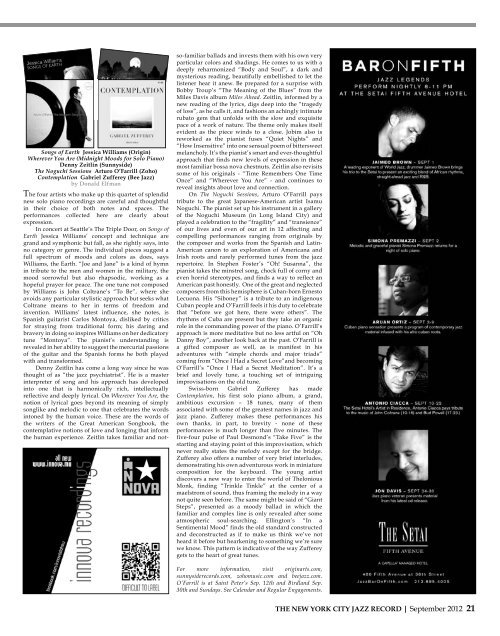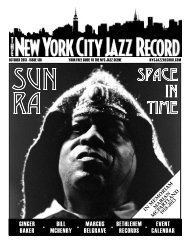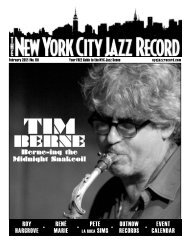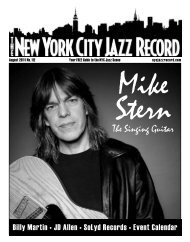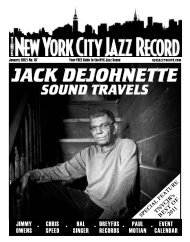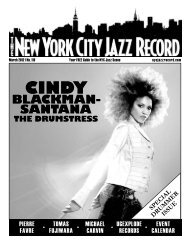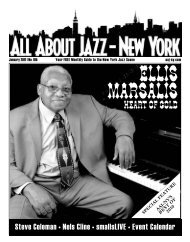September 2012 - The New York City Jazz Record
September 2012 - The New York City Jazz Record
September 2012 - The New York City Jazz Record
You also want an ePaper? Increase the reach of your titles
YUMPU automatically turns print PDFs into web optimized ePapers that Google loves.
Songs of Earth Jessica Williams (Origin)<br />
Wherever You Are (Midnight Moods for Solo Piano)<br />
Denny Zeitlin (Sunnyside)<br />
<strong>The</strong> Noguchi Sessions Arturo O’Farrill (Zoho)<br />
Contemplation Gabriel Zufferey (Bee <strong>Jazz</strong>)<br />
by Donald Elfman<br />
<strong>The</strong> four artists who make up this quartet of splendid<br />
new solo piano recordings are careful and thoughtful<br />
in their choice of both notes and spaces. <strong>The</strong><br />
performances collected here are clearly about<br />
expression.<br />
In concert at Seattle’s <strong>The</strong> Triple Door, on Songs of<br />
Earth Jessica Williams’ concept and technique are<br />
grand and symphonic but fall, as she rightly says, into<br />
no category or genre. <strong>The</strong> individual pieces suggest a<br />
full spectrum of moods and colors as does, says<br />
Williams, the Earth. “Joe and Jane” is a kind of hymn<br />
in tribute to the men and women in the military, the<br />
mood sorrowful but also rhapsodic, working as a<br />
hopeful prayer for peace. <strong>The</strong> one tune not composed<br />
by Williams is John Coltrane’s “To Be”, where she<br />
avoids any particular stylistic approach but seeks what<br />
Coltrane means to her in terms of freedom and<br />
invention. Williams’ latest influence, she notes, is<br />
Spanish guitarist Carlos Montoya, disliked by critics<br />
for straying from traditional form; his daring and<br />
bravery in doing so inspires Williams on her dedicatory<br />
tune “Montoya”. <strong>The</strong> pianist’s understanding is<br />
revealed in her ability to suggest the mercurial passions<br />
of the guitar and the Spanish forms he both played<br />
with and transformed.<br />
Denny Zeitlin has come a long way since he was<br />
thought of as “the jazz psychiatrist”. He is a master<br />
interpreter of song and his approach has developed<br />
into one that is harmonically rich, intellectually<br />
reflective and deeply lyrical. On Wherever You Are, the<br />
notion of lyrical goes beyond its meaning of simply<br />
songlike and melodic to one that celebrates the words<br />
intoned by the human voice. <strong>The</strong>se are the words of<br />
the writers of the Great American Songbook, the<br />
contemplative notions of love and longing that inform<br />
the human experience. Zeitlin takes familiar and not-<br />
so-familiar ballads and invests them with his own very<br />
particular colors and shadings. He comes to us with a<br />
deeply reharmonized “Body and Soul”, a dark and<br />
mysterious reading, beautifully embellished to let the<br />
listener hear it anew. Be prepared for a surprise with<br />
Bobby Troup’s “<strong>The</strong> Meaning of the Blues” from the<br />
Miles Davis album Miles Ahead. Zeitlin, informed by a<br />
new reading of the lyrics, digs deep into the “tragedy<br />
of loss”, as he calls it, and fashions an achingly intimate<br />
rubato gem that unfolds with the slow and exquisite<br />
pace of a work of nature. <strong>The</strong> theme only makes itself<br />
evident as the piece winds to a close. Jobim also is<br />
reworked as the pianist fuses “Quiet Nights” and<br />
“How Insensitive” into one sensual poem of bittersweet<br />
melancholy. It’s the pianist’s smart and ever-thoughtful<br />
approach that finds new levels of expression in these<br />
most familiar bossa nova chestnuts. Zeitlin also revisits<br />
some of his originals - “Time Remembers One Time<br />
Once” and “Wherever You Are” - and continues to<br />
reveal insights about love and connection.<br />
On <strong>The</strong> Noguchi Sessions, Arturo O’Farrill pays<br />
tribute to the great Japanese-American artist Isamu<br />
Noguchi. <strong>The</strong> pianist set up his instrument in a gallery<br />
of the Noguchi Museum (in Long Island <strong>City</strong>) and<br />
played a celebration to the “fragility” and “transience”<br />
of our lives and even of our art in 12 affecting and<br />
compelling performances ranging from originals by<br />
the composer and works from the Spanish and Latin-<br />
American canon to an exploration of Americana and<br />
Irish roots and rarely performed tunes from the jazz<br />
repertoire. In Stephen Foster’s “Oh! Susanna”, the<br />
pianist takes the minstrel song, chock full of corny and<br />
even horrid stereotypes, and finds a way to reflect an<br />
American past honestly. One of the great and neglected<br />
composers from this hemisphere is Cuban-born Ernesto<br />
Lecuona. His “Siboney” is a tribute to an indigenous<br />
Cuban people and O’Farrill feels it his duty to celebrate<br />
that “before we got here, there were others”. <strong>The</strong><br />
rhythms of Cuba are present but they take an organic<br />
role in the commanding power of the piano. O’Farrill’s<br />
approach is more meditative but no less artful on “Oh<br />
Danny Boy”, another look back at the past. O’Farrill is<br />
a gifted composer as well, as is manifest in his<br />
adventures with “simple chords and major triads”<br />
coming from “Once I Had a Secret Love”and becoming<br />
O’Farrill’s “Once I Had a Secret Meditation”. It’s a<br />
brief and lovely tune, a touching set of intriguing<br />
improvisations on the old tune.<br />
Swiss-born Gabriel Zufferey has made<br />
Contemplation, his first solo piano album, a grand,<br />
ambitious excursion – 18 tunes, many of them<br />
associated with some of the greatest names in jazz and<br />
jazz piano. Zufferey makes these performances his<br />
own thanks, in part, to brevity - none of these<br />
performances is much longer than five minutes. <strong>The</strong><br />
five-four pulse of Paul Desmond’s “Take Five” is the<br />
starting and staying point of this improvisation, which<br />
never really states the melody except for the bridge.<br />
Zufferey also offers a number of very brief interludes,<br />
demonstrating his own adventurous work in miniature<br />
composition for the keyboard. <strong>The</strong> young artist<br />
discovers a new way to enter the world of <strong>The</strong>lonious<br />
Monk, finding “Trinkle Tinkle” at the center of a<br />
maelstrom of sound, thus framing the melody in a way<br />
not quite seen before. <strong>The</strong> same might be said of “Giant<br />
Steps”, presented as a moody ballad in which the<br />
familiar and complex line is only revealed after some<br />
atmospheric soul-searching. Ellington’s “In a<br />
Sentimental Mood” finds the old standard constructed<br />
and deconstructed as if to make us think we’ve not<br />
heard it before but hearkening to something we’re sure<br />
we know. This pattern is indicative of the way Zufferey<br />
gets to the heart of great tunes.<br />
For more information, visit originarts.com,<br />
sunnysiderecords.com, zohomusic.com and beejazz.com.<br />
O’Farrill is at Saint Peter’s Sep. 12th and Birdland Sep.<br />
30th and Sundays. See Calendar and Regular Engagements.<br />
THE NEW YORK CITY JAZZ RECORD | <strong>September</strong> <strong>2012</strong> 21


